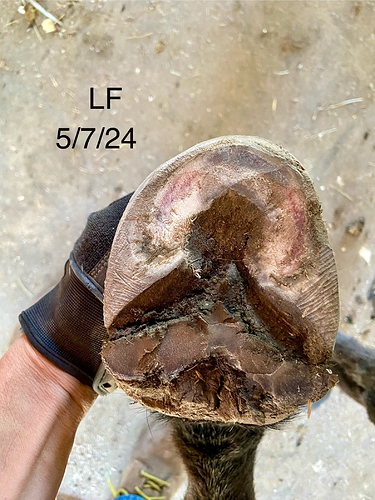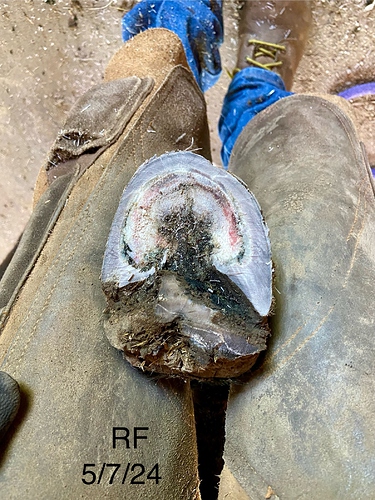How long is the red laminie visible on the sole after a flair up? IOW, if the episode happened on March 1, would it be visible to the farrier when he/she did a trim 4-6 weeks later?
Sounds like a hoof bruise and yes. Still visible until it grows out, but if you are talking about rings or something else, I’m not sure.
Thank you! Not talking about rings on the exterior, just the sole.
Yes, I think it could be. It may depend on the severity of the laminitis.
It was odd. There were zero signs of a laminitis event based on gait & stance. When my farrier was here to trim he discovered it in both front hooves. At the next trim, 6 weeks later, the soles were back to normal. I was just trying to narrow down the time frame of when it happened.
Also, there was zero rotation in her front hooves. 
it depends on where the lamina were impacted, and to what degree
Feet grow on average around 1/4" a month.
Are you saying the SOLE is bruised/red, or by “on the sole” do you mean at ground level but the lamina connecting sole to hoof wall?
ohhhh ouch  That’s a sign of founder. You’re seeing the outline of the coffin bone as it pressed too hard for too long against a too-thin sole. The bruising will be visible until both the cause of it stops, and the thickness of the sole sheds off
That’s a sign of founder. You’re seeing the outline of the coffin bone as it pressed too hard for too long against a too-thin sole. The bruising will be visible until both the cause of it stops, and the thickness of the sole sheds off
What is weird is that she exhibited zero signs lameness and was never parked out. She lives on a dry lot but last winter I had to use round bales so that contributed to it. No grain. I just can’t wrap my head those soles and her not tippy-toeing. 
The bruising was all gone at the next trim 6 weeks later.
We did bloodwork in June and learned she has Cushings & Equine Metabolic syndrome. The two meds have made a major improvement in her and with strict diet controls, she has lost 55 pounds as of 2 weeks ago.
If they’re “just” sinking, as opposed to rotating, it may not make them take the typical parked out stance, which they usually do to relieve pressure on the toes
soles tend to grow out pretty quickly. If you don’t have a recent set of xrays that would be a great idea
Ahh, I didn’t know that about sink verses rotate stance, thank you!
We did X-rays in June on her fronts and everything was good. I use a regionally known equine only practice, top tier staff.
what was the sole thickness then? Was her bony column back in alignment?
What a timely thread. I was at a friend’s house today to get her donkey looked at by the vet for laminitis. The donkey was turned out to pasture this summer and had a cresty neck and some fat pads. Has shown shifting lameness since. He looked off on his hind and then on both fronts. The vet today did not think he had laminitis. She just suggested a good farrier and said that he had white line disease. He didn’t look that lame today but he was still lame.
Would white line typically cause lameness? My friend is trying to find a better farrier. I’m still not convinced this isn’t laminitis. No x rays were take
at this time.
He is mostly walking on his overgrown sole and the hoof wall has been eaten away by white line (at least in the toe).
I did not write down her sole thickness but Doc did not express concern. Bony column was fine.
Cresty neck & fat pads indicate problems. The donkey should not be on pasture unless it looks like a cement parking lot.
My donkey had this bout from free choice hay and the two undiagnosed health conditions.
He has been getting turn out with a grazing muzzle. Would keeping him on a drylot at all times be preferable? As I can suggest that. But then the horse can’t go out without the donkey (because they are buddy sour).
The reason I have always dry lotted my donkey is because they are thrifty eaters. Their genetics allow them to live off eating brush, vines, some weeds, etc. Their diet doesn’t need the same level of nutrients as horses. This is the reason I do not advise keeping a donkey as a pasture pal for a horse unless both are on a diet.
I feed wheat straw (not oat straw) as a low calorie, low sugar munchie.
So without seeing your friends donkey body score or the pasture, only going off the info about the two fatty deposits, being in a dry lot for all or part of the day isn’t going to hurt it. There is always the possibility that there are other medical issues going on with the donkey as I found out with mine.
I’ve never dealt with White line disease so others will have to advise you on that condition. I do believe it requires pretty aggressive treatment to stop the problem- by aggressive I think daily cleaning, etc.
Good luck helping your friend!! This website provides accurate information about donkeys. Look under the Donkey Care tab for more info.
Your friend needs a new vet, and to get that donkey off all grass. Donkeys need low quality hay. Yes, low quality. They are more metabolically efficient, with lower nutritional needs, than horses.
Dry lot at least for now. Clearly the grazing muzzle hasn’t prevented the fat pads and cresty neck. Maybe he can be out there in December-Feb, depending on where your friend lives.
This is the reason it’s not a good idea to get a donkey as a companion for their horse on pasture  Yes, occasionally a donk is fine out there. Most aren’t.
Yes, occasionally a donk is fine out there. Most aren’t.
There likely is some WLD at this point with overgrown feet that have allowed separately of the white line which has allowed opportunistic bacteria in.
The Donkey Sanctuary link is a great one, they are almost the gold standard for donkey care.


